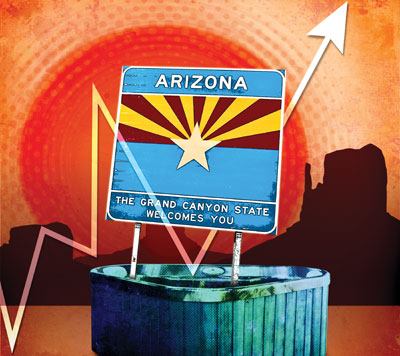Will to Survive
Four Phoenix retailers beat the odds and live to tell the tale.

PHOTO: Denise Baker

PHOTO: Denise Baker
Five years ago, 78 hot tub stores were spread along the 518 square miles of desert land that make up the Valley of the Sun. Today, less than 25 remain, representing just a small handful of dealers.
“It was a bloodbath,” recalls Thomas Halvorsen, CEO and partner of Spas of Arizona, LLC in Phoenix. “It dropped off a cliff from the best it’s ever been to where we are today. [We haven’t had] a lot of sleep in the last five years.”
Although retailers throughout the country have recounted similar stories, Phoenix was hit especially hard by the plummeting housing market, and today Arizona ranks third-highest in foreclosure activity nationwide.
Despite these dismal figures, a number of dealers refused to give up without a fight. Attrition certainly helped their survival, but it wasn’t the sole reason they were able to stay afloat.
Spas of Arizona maintained a “never say die” attitude, and made whatever changes were necessary to get through the slump. Unfortunately, that meant cutting jobs and closing stores, and between 2005 and 2011 the company downsized from 12 locations to four. Halvorsen and his team also took a close look at their spending habits, examining how they ran their business and adopting a new sales philosophy along the way.
“We went from fat and sassy to a lean and mean machine,” he says. “Even after 36 years in business, we’ve learned a lot of lessons. We have to look at it like that or we would do a lot of crying.”
During the restructuring, Halvorsen discovered one major perk to running a business in Phoenix’s struggling economy. With so many retailers in the area closing their doors, properties sat vacant with no one to pay the bills. The price of commercial real estate sunk to nearly one-tenth the cost of what it had been before the bubble burst.
Spas of Arizona used this to its advantage. Now the dealer has its four remaining stores viewable and accessible from a major freeway. The company even was able to negotiate freeway signage — a luxury often afforded to big box stores — which drivers find nearly impossible to ignore during their evening commute. After almost two years, Halvorsen says the strategy is beginning to pay off.
His stores experienced an increase in sales of roughly 20 percent between August and December 2011.
“The last four months we’ve seen a lot of light at the end of the tunnel,” Halvorsen says. “[In the past when that happened] we would think, ‘OK here it comes, business is coming back.’ And then it would die again,” he says. “But 20 percent of next to nothing seems like a million percent.”
The past several months also have been profitable for Sunset Spas, says the Chandler-based store’s General Manager Larry Staeb. The dealer is fairly new to the Phoenix region — owner Dave Rempfer opened the store in 2006, just before the recession took its toll.
“Everything just collapsed shortly thereafter, and the whole world changed actually right around that time,” he says.
Fortunately, Rempfer’s industry experience helped the company stay in business, Staeb says. Rempfer previously ran Spa & Billiards Outlet in California, and then Sunset Spas in Las Vegas before relocating to Arizona.
Shasta Pools & Spas (which plans to finalize a deal in February to sell its six retail stores to Leslie’s Poolmart) has maintained steady hot tub sales. Company officials site the firm’s longevity, as well as an influx of second home-buyers from Canada — and more recently North Dakota — purchasing property at price tags 60-plus percent lower than in 2007, says Sales Manager Bill Gullekson. A growth in building and the “staycation” mindset of those who were fortunate enough to keep their houses has sparked an increase as well.
To sweeten the deal, Shasta began offering packages to builders and bundle options to customers seeking more features for their hot tubs, a move that has proven fruitful in the last six months. In all, Gullekson says 2012 looks very promising and he anticipates a 100- to 120-percent jump in hot tub sales. In preparation, the company revamped two of its design centers in October with the sole purpose of highlighting more acrylic spas, he adds.
Paddock Pools, Patios & Spas had similar luck after rethinking its customer base, says Darrell Voionmaa, spa sales manager. Until recently, the 53-year-old company had catered mostly to high-end consumers. But that all changed in the mid-2000s when it developed a hot tub refurbish business. Paddock utilized its service department to spruce up some old spas the retailer had on hand, and then advertised them at a price point between $3,900 and $6,000. The response was greater than anticipated.
“People just beat down our door,” adds Ted Harry, director of stores. “We found the magic number.”
Pinpointing this figure prompted Paddock to seek out a manufacturer that could provide a less expensive spa that still featured some of the options consumers desired. After two years of conversations, a vendor finally produced one, Harry explains. In February 2010, Paddock brought on the only other brand of hot tubs the store has carried since it began selling them more than 20 years ago.
Since then, Paddock has increased its hot tub sales upwards of 70 percent compared to the year prior. In 2010, the retailer also opened two new stores in Phoenix.“We have just done gangbusters with it,” Harry says.


